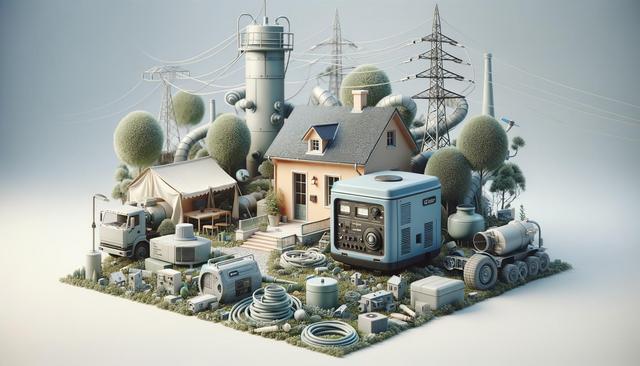Understanding the Need for Home Generators
As weather patterns grow more unpredictable and power grids face increasing strain, homeowners are turning to home generators to ensure consistent electricity during outages. From severe storms to aging infrastructure, the causes of blackouts are varied—but the solution for many is increasingly clear. Home generators offer peace of mind, enabling families to maintain essential functions like refrigeration, lighting, and heating when the main power supply fails. These systems are no longer considered luxury items; instead, they are becoming essential equipment in many households, particularly in regions prone to extreme weather.
Home generators come in various types, including portable and standby models. While portable units are more affordable and easier to store, standby generators provide an automatic response to power loss and are hardwired into a home’s electrical system. This automatic transition is a significant benefit for homeowners who may be away during an outage or unable to manually start a generator. The growing frequency of outages has made reliability a top priority, prompting many to invest in models that balance performance and efficiency.
Types of Home Generators: What to Consider
Choosing the right generator depends on several factors, including power needs, budget, and installation options. There are three main types of home generators:
- Portable Generators: Ideal for short-term use and powering select appliances. They typically run on gasoline or propane and require manual setup.
- Inverter Generators: Known for quieter operation and cleaner energy output, these are suitable for sensitive electronics and smaller households.
- Standby Generators: Permanently installed outside the home, they activate automatically during outages and can power the entire house.
Standby generators often require professional installation and a connection to a fuel source such as natural gas or propane. While the upfront investment is higher, the convenience and power capacity justify the cost for many homeowners. Inverter models, on the other hand, are often chosen for their efficiency and portability, especially for those who need a backup for only a few essential devices.
Features to Look For in a Reliable Generator
Not all generators perform equally, and understanding key features can help homeowners make informed decisions. Among the most valued features are:
- Automatic Transfer Switch (ATS): Automatically switches the power source to the generator when a blackout occurs.
- Fuel Efficiency: Units that consume less fuel while delivering consistent power are favored for both environmental and economic reasons.
- Noise Level: Generators with lower decibel ratings are better suited for residential neighborhoods.
- Remote Monitoring: Some modern models allow users to monitor generator status and fuel levels via smartphone apps.
In addition to these features, safety mechanisms like overload protection and carbon monoxide detection are crucial. These ensure that the generator operates safely and shuts down in risky situations. Homeowners should also check for certifications and compliance with local regulations before installation.
Popular Generator Sizes and Their Applications
Generator size is often measured in kilowatts (kW), and selecting the right size is essential for optimal performance. Smaller generators, such as those in the 3kW to 5kW range, are suitable for limited use—powering lights, a refrigerator, and a few outlets. Mid-range models between 7kW and 12kW can handle multiple appliances and systems, including home security and sump pumps. For whole-house coverage, generators with a capacity of 20kW or more are typically required.
Here is a general guide to match generator size with household needs:
- 3kW–5kW: Basic essentials (lights, fridge, small electronics)
- 7kW–12kW: Medium load (appliances, heating systems, select rooms)
- 20kW and above: Whole-house backup (all appliances, HVAC, home office)
It’s advisable to consult an electrician or generator specialist when determining the exact power requirements. Overestimating can lead to unnecessary costs, while underestimating can result in insufficient backup power during critical moments.
Installation and Maintenance Considerations
Installing a home generator involves more than just purchasing the unit. For standby models, professional installation is typically required to connect the generator to the home’s electrical panel and fuel supply. This ensures safe operation and compliance with local codes. Portable generators, while simpler to set up, still require proper positioning to prevent risks such as carbon monoxide buildup.
Maintenance is equally important to ensure longevity and reliability. Regular checks and servicing can prevent common issues and extend the life of the generator. Key maintenance tasks include:
- Changing the oil and air filters
- Inspecting spark plugs and fuel lines
- Running the generator periodically to keep components functional
- Checking battery levels and ensuring a stable connection
Many homeowners opt for service contracts that provide scheduled maintenance and emergency support. These plans offer reassurance that the generator will operate smoothly when needed most. Whether opting for a portable or permanent unit, understanding the responsibilities of ownership helps avoid unexpected failures during outages.
Conclusion: Planning Ahead with Confidence
With power outages becoming more frequent, investing in a home generator is a practical step toward energy resilience. Whether you’re looking for backup power for a few essentials or aiming to keep your entire home running without interruption, there’s a generator solution that fits your needs. By understanding the different types, features, and installation considerations, homeowners can make informed choices that align with their lifestyle and budget.
Taking the time to plan and prepare not only increases comfort during outages but also protects household safety and security. As more people recognize the value of reliable backup power, home generators are evolving from optional equipment to an integral part of modern home infrastructure.




Leave a Reply